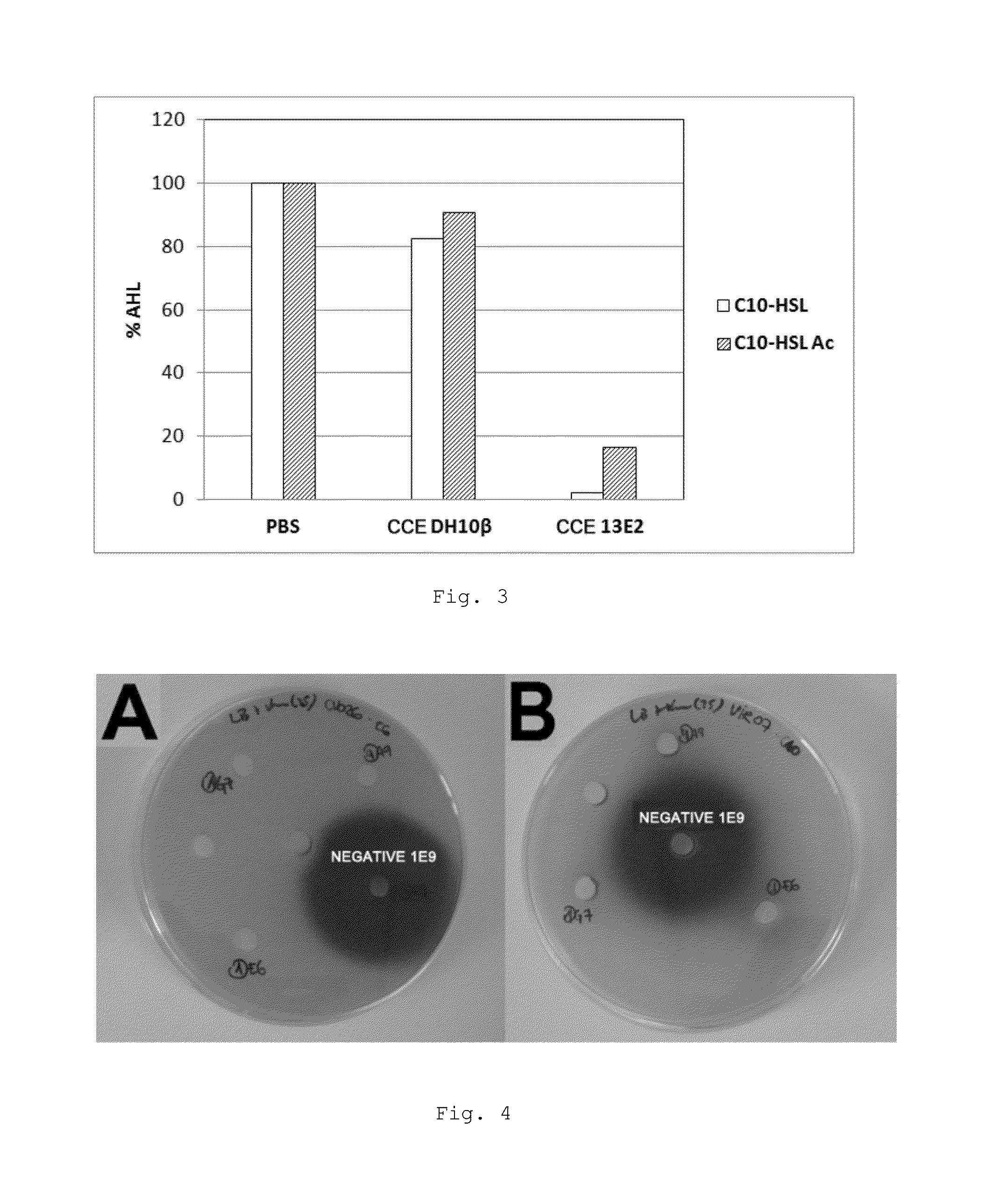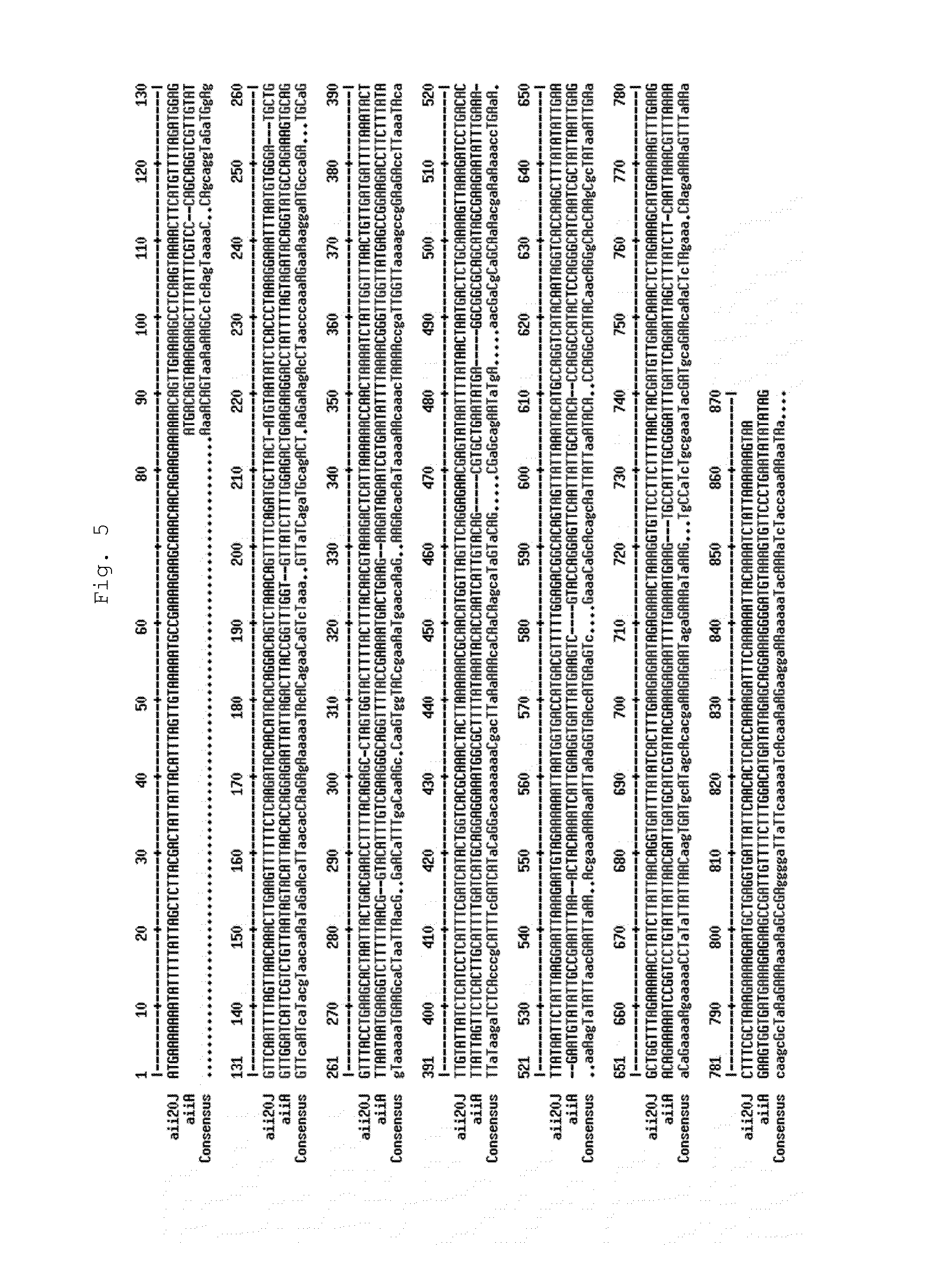Peptide with quorum-sensing inhibitory activity, polynucleotide that encodes said peptide, and the uses thereof
a technology of peptides and inhibitors, applied in the direction of peptides/protein ingredients, antibacterial agents, peptide sources, etc., can solve the problems of large economic losses, fatal infections, and hygiene problems, and achieve the effect of reducing the risk of food-borne diseases
- Summary
- Abstract
- Description
- Claims
- Application Information
AI Technical Summary
Benefits of technology
Problems solved by technology
Method used
Image
Examples
example 1
Identification of Aii20J, Gene Responsible for QQ Activity in Tenacibacullum sp. Strain 20J
1.1 Construction of a Fosmid Genomic Library and Functional Screening
[0155]For the purpose of identifying and cloning the gene or genes responsible for the activity of degrading AHLs of Tenacibaculum sp. strain 20J (CECT 7426), a genomic library was constructed using the CopyControl™ Fosmid Library Production Kit (Epicentre, Madison, Wis.) with the pCC2FOS vector according to the manufacturer's protocol.
[0156]Tenacibaculum sp. strain 20J DNA was extracted by means of the Wizard Genomic DNA Purification kit (Promega, Madison, Wis.) according to the manufacturer's instructions. The DNA (2.5 μg) was randomly fragmented by means of pipetting (50-100 times) with a 200 μL pipette tip. The fragmented DNA was treated enzymatically to repair and generate phosphorylated and blunt ends. 40 kb fragments were then selected by means of pulsed-field gel electrophoresis (PFGE) and were ligated into the linear...
example 2
Sequencing Genes Homologous to the Tenacibaculum sp. Strain 20J QQ Gene in Other Strains of the Genus Tenacibaculum
[0171]The presence of genes homologous to Aii20J in other species of the genus Tenacibaculum, which are shown in Table 2, was verified. Firstly, a bioassay was performed in solid medium to verify that the living cells of these strains were capable of degrading C6-HSL and C10-HSL. Only the two strains of T. maritimum did not show activity of degrading them, in contrast with previous analyses, which described that T. maritimum NCBI 2154T presented activity against C10-HSL. This difference is probably due to the fact that, in this case, the assay for activity was performed in controlled pH conditions (living cells resuspended in PBS, pH 6.5), whereas this assay was previously performed directly in the culture medium, and therefore, the degradation could be derived from high pH values derived from metabolic activity of the bacterium. Two of the tested species, T. aestuarii...
example 3
Overexpression, Purification and Characterization of Aii20J Enzyme Activity
3.1 Cloning and Overexpression
[0175]As described in the preceding section, the sequence of aii20J was amplified by means of PCR with specific primers that allowed inserting the restriction targets compatible with expression plasmid pET28c(+) (Novagen). This vector was chosen because it has the possibility of performing directional cloning and adds a fusion protein, in this case a polyhistidine tag (6 consecutive histidine residues) at the N-terminus, making protein purification easier.
[0176]The result of PCR amplification was run in 1% agarose gel electrophoresis and the corresponding DNA bands were extracted by means of the Gel Extraction Kit (Omega) following the manufacturer's protocol. Plasmid pET28c(+) was extracted in parallel from the strain where it was cultured in a routine manner (E. coli XL1blue) by means of miniprep with the Quiagen QIAprep® Spin Miniprep Kit following the manufacturer's protocol....
PUM
| Property | Measurement | Unit |
|---|---|---|
| Fraction | aaaaa | aaaaa |
| Fraction | aaaaa | aaaaa |
Abstract
Description
Claims
Application Information
 Login to View More
Login to View More - R&D
- Intellectual Property
- Life Sciences
- Materials
- Tech Scout
- Unparalleled Data Quality
- Higher Quality Content
- 60% Fewer Hallucinations
Browse by: Latest US Patents, China's latest patents, Technical Efficacy Thesaurus, Application Domain, Technology Topic, Popular Technical Reports.
© 2025 PatSnap. All rights reserved.Legal|Privacy policy|Modern Slavery Act Transparency Statement|Sitemap|About US| Contact US: help@patsnap.com



